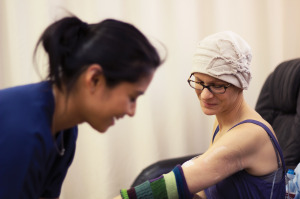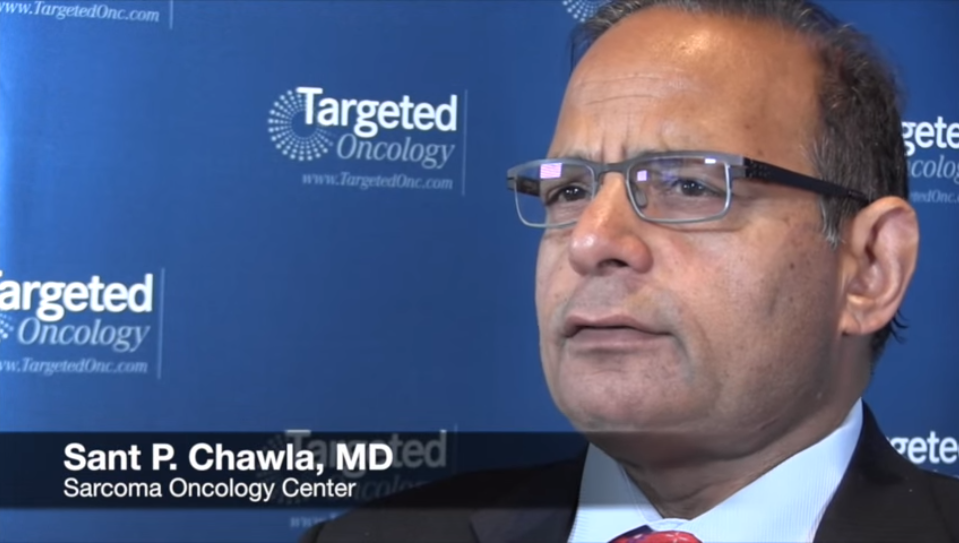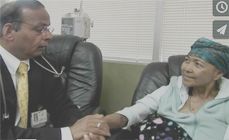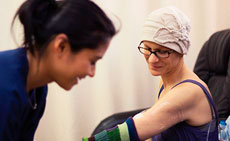The place where a sarcoma starts is called the “primary site.” Surgical removal of the primary sarcoma, which is sometimes followed by radiation therapy, cures many patients. For some patients, however, sarcoma spreads through the bloodstream to distant sites in the body such as the lungs or liver. The process of the tumor spreading to other areas is called “metastasis,” and the secondary sites are called “metastases.” Fortunately, fewer than 20 percent of all soft-tissue sarcomas have metastasized before they are diagnosed.

Chemotherapy for Distant Recurrence and Metastasis
 Surgery and radiation therapy target specific areas of the body, but chemotherapy is different because it travels through the bloodstream to all areas and systems of the body. For that reason, chemotherapy is called a “systemic treatment.”
Surgery and radiation therapy target specific areas of the body, but chemotherapy is different because it travels through the bloodstream to all areas and systems of the body. For that reason, chemotherapy is called a “systemic treatment.”
When a patient’s tumor is a type that might spread, chemotherapy can be used as an adjuvant (additional) therapy either before or after surgery. In addition to destroying microscopic areas of metastasis if it exists, chemotherapy can also be used to reduce the size of the primary sarcoma before surgery, improving the chances of as much limb and tissue preservation possible.
Even patients who appear to have only a primary sarcoma could have microscopic metastases that cannot be detected even with advanced imaging techniques. Although it can never be certain which patients might harbor microscopic deposits of sarcoma, doctors can estimate whether a tumor might spread based on the size of a sarcoma and its appearance under the microscope.
Chemotherapy given after surgical removal of the primary tumor might eliminate micrometastases, but the evidence for this is controversial and is best discussed on a case-by-case basis with the oncologist.
Doctors often use chemotherapy for patients with large, fast-growing sarcomas. The terms “neoadjuvant chemotherapy,” “cytotoxic therapy,” and “preoperative chemotherapy” apply to these instances. In addition to destroying microscopic areas of metastasis (if they exist), this approach often reduces the size of the primary sarcoma allowing the surgeon to perform a less radical operation and possibly save some patients from amputation. Preoperative chemotherapy could also contribute to better chances of survival. Critical to the success of this strategy is the involvement of a coordinated team of doctors and nurses which is the strategy used by the Sarcoma Oncology Center.
Future Experimental Therapies
 With over 30 years of medical and clinical research experience, Dr. Chawla partners with the chemo experts at The Sarcoma Center to continue his pioneering work as a leader in experiential treatments and clinical trial drugs using some of the new advanced therapies for many of his cancer patients. His efforts have resulted in breakthroughs in experiential therapies, including Immunotherapy Targeted Therapy, Long Term Interferon Treatment, Malignant Tumor Removal, and Therapeutic Tumor Vaccines. The Sarcoma Center’s integrated treatment approach may include options for experiential therapies as part of a patient’s comprehensive cancer care.
With over 30 years of medical and clinical research experience, Dr. Chawla partners with the chemo experts at The Sarcoma Center to continue his pioneering work as a leader in experiential treatments and clinical trial drugs using some of the new advanced therapies for many of his cancer patients. His efforts have resulted in breakthroughs in experiential therapies, including Immunotherapy Targeted Therapy, Long Term Interferon Treatment, Malignant Tumor Removal, and Therapeutic Tumor Vaccines. The Sarcoma Center’s integrated treatment approach may include options for experiential therapies as part of a patient’s comprehensive cancer care.
The Sarcoma Oncology Center collaborates with other centers to provide PD1 and PDL1 Inhibitor treatment and Hyperthermia Therapy for cancer. We partner with our patients for the most effective treatment plan encouraging them to participate with us for the best possible outcome. As with any treatment, experiential therapies might have side effects. By working closely with our patients, we help them to minimize any discomfort that arises.
Over the next five years, Dr. Chawla’s medical research will continue its focus on development of cancer gene therapy, vaccines, immunotherapies (treatments that use the body’s own defenses to combat cancer) and anti-angiogenic agents (drugs to block development of blood vessels and starve the tumor) to treat soft-tissue sarcomas. As we move forward into the future, we will learn better techniques and have better understanding of how to cure cancer. Contact the Sarcoma Oncology Center for more information about these revolutionary treatments.
Contact the Sarcoma Oncology Specialists Today
Sarcoma Oncology Center offers patients the best possible solution while respecting the physical and emotional health of each patient. We offer multiple cancer treatment options and analysis. Contact our center at 310-552-9999 to arrange a consultation with one of our oncologists for an appointment. We offer chemo in Santa Monica, and the Great Los Angeles area. We would like to discuss your personal situation with you and answer questions that you might have at this time.
Next, learn more about the Sarcoma Oncology Center’s multi-modal treatment approach.
Standard Treatment
Generally Accepted Systematic Therapy Agents and Regiments a, b
Combination regimens
AD (Doxorubicin, Dacarbazine)
AIM (Doxorubicin, Ifosfamide, Mesna)
MAID (Mesna, Doxorubicin, Ifosfamide, Dacarbazine)
Ifosfamide, Epirubicin, Mesna
Gemcitabine and Docetaxel
Single agents
Doxorubicin
Ifosfamide
Epirubicin
Gemcitabine
Dacarbazine
Liposomal Doxorubicin
Special situations
Desmoid Tumors
Sulindac or other non-steroidal anti-inflammatory drugs (NSAIDS) including Celecoxib *
Tamoxifen
Toremifene
Methotrexate and Vinblastine
Low-dose Interferon
Doxorubicin-based regimens
Imatinib Mesylate
Angiosarcoma
Paclitaxel Docetaxel
Vinorelbine
GIST
Imatinib Mesylate
Sunitinib Malate
* The risk of cardiovascular events may be increased in patients receiving Celecoxib. Physicians prescribing Celecoxib should consider this emerging information when weighing the benefits against risks for individual patients. (FDA Talk Paper T04-61, Dec 23, 2004)
aAlveolar soft part sarcoma and clear cell sarcomas are generally not sensitive to chemotherapy but at this time several new drugs are being tested.
bReferences for regimens, see SARC-C 2 of 2.
Next, read about Clinical Trials.





